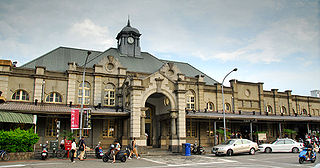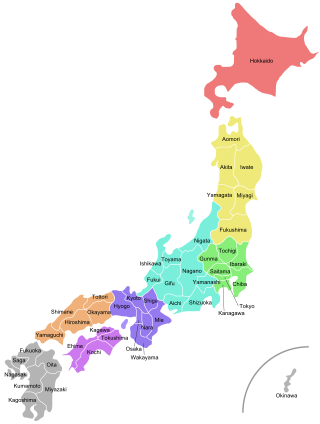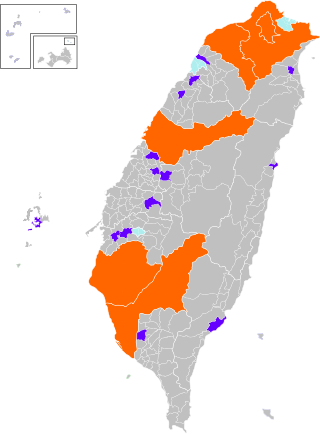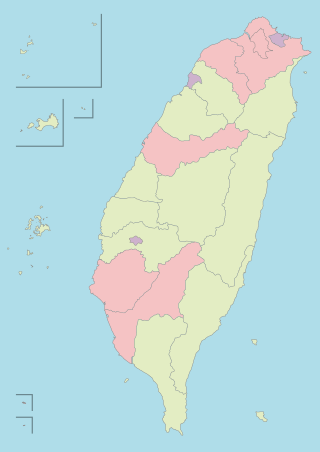
Taiwan Province is a de jure administrative division of the Republic of China (ROC). Provinces remain a titular division as a part of the Constitution of the Republic of China, but are no longer considered to have any administrative function practically.

Japan is divided into 47 prefectures, which rank immediately below the national government and form the country's first level of jurisdiction and administrative division. They include 43 prefectures proper, two urban prefectures, one regional prefecture and one metropolis. In 1868, the Meiji Fuhanken sanchisei administration created the first prefectures to replace the urban and rural administrators in the parts of the country previously controlled directly by the shogunate and a few territories of rebels/shogunate loyalists who had not submitted to the new government such as Aizu/Wakamatsu. In 1871, all remaining feudal domains (han) were also transformed into prefectures, so that prefectures subdivided the whole country. In several waves of territorial consolidation, today's 47 prefectures were formed by the turn of the century. In many instances, these are contiguous with the ancient ritsuryō provinces of Japan.
The administrative divisions of China have consisted of several levels since ancient times, due to China's large population and geographical area. The constitution of China provides for three levels of government. However in practice, there are five levels of local government; the provincial, prefecture, county, township, and village.
Taiwan is divided into multi-layered statutory subdivisions. Due to the complex political status of Taiwan, there is a significant difference in the de jure system set out in the original constitution and the de facto system in use today.

A prefecture-level city or prefectural city is an administrative division of the People's Republic of China (PRC), ranking below a province and above a county in China's administrative structure.

A county-administered city is a third-level administrative division in the Republic of China (Taiwan) below a county, which in turn is below of a province. Under the administrative structure of the ROC, it is at the same level as a township or a district. Such cities are under the jurisdiction of counties. It is also the lowest-level city in Taiwan, below a city and a special municipality. There are 14 county-administered cities currently under ROC control.
The elections in Taiwan each held every four years, typically in January and November. Since 2012 the previously eleven types of elections in Taiwan have been unified into general and local elections. There may also be by-elections. Electoral systems include first-past-the-post, proportional representation, single non-transferable voting, and a parallel mixture of the above.
Taiwan was under Japanese rule after the First Sino-Japanese War, as per the Treaty of Shimonoseki of 1895. There were still several changes until the Japanese political system was adopted in 1920. This system was de facto abolished in 1945 and de jure in 1952.

Fuchien Province, also romanized as Fujian and rendered as Fukien, is a nominal province of the Republic of China without formal administrative function. It includes three small archipelagos off the coast of the Fujian Province of the People's Republic of China, namely the Matsu Islands, which make up Lienchiang County, and the Wuqiu Islands and Kinmen Islands, which make up Kinmen County. The seat of the administrative centre is Jincheng Township of Kinmen County which serves as its de facto capital. The province is also known as the Golden Horse, after the literal reading of the Chinese character abbreviation for "Kinmen-Matsu".

The free area of the Republic of China, also known as the "Taiwan Area of the Republic of China", the "Tai-Min Area " or simply the "Taiwan Area", is a term used by the government of the Republic of China (Taiwan) to refer to the territories under its actual control. It is also used as a legal term written in the Additional articles of the ROC constitution and Cross-Strait Act.
In recent years there have been calls to reform the administrative divisions and levels of China, which is defined either the People's Republic of China or the Republic of China.
Districts are administrative subdivisions of the Republic of China (Taiwan)'s special municipalities of the second level and provincial cities of the third level formerly under its provinces. There are two types of district in the administrative scheme.

A county, constitutionally known as a hsien, is a de jure second-level administrative division unit in the Republic of China (Taiwan). Under the administrative structure of Taiwan, it is with the same level of a provincial city.

Special municipality, historically known as Yuan-controlled municipality, is a first-level administrative division unit in Taiwan. It is the highest level of the country's administrative structure and is equivalent to a province. After the suspension of the provincial governments of 2018, the special municipalities along with provincial cities and counties have all governed directly under the central government.
Villages are the basic level administrative subdivisions of the Republic of China, under townships, county-administered cities or districts. There are two types of villages depending on the divisions it belongs to.
The administrative divisions of China between 1912 and 1949 were established under the regime of the Republic of China government.

China is officially divided into 339 prefecture-level divisions, which rank below provinces and above counties as the second-level administrative division in the country. Of these, 333 are located in territory controlled by the People's Republic of China, while 6 are located in land controlled by Taiwan.

The People's Republic of China (PRC) is divided into 2,854 county-level divisions which rank below prefectures/provinces and above townships as the third-level administrative division in the country. Of these, 2,842 are located in territory controlled by the PRC, while 172 are located in land controlled by the Republic of China (ROC).










